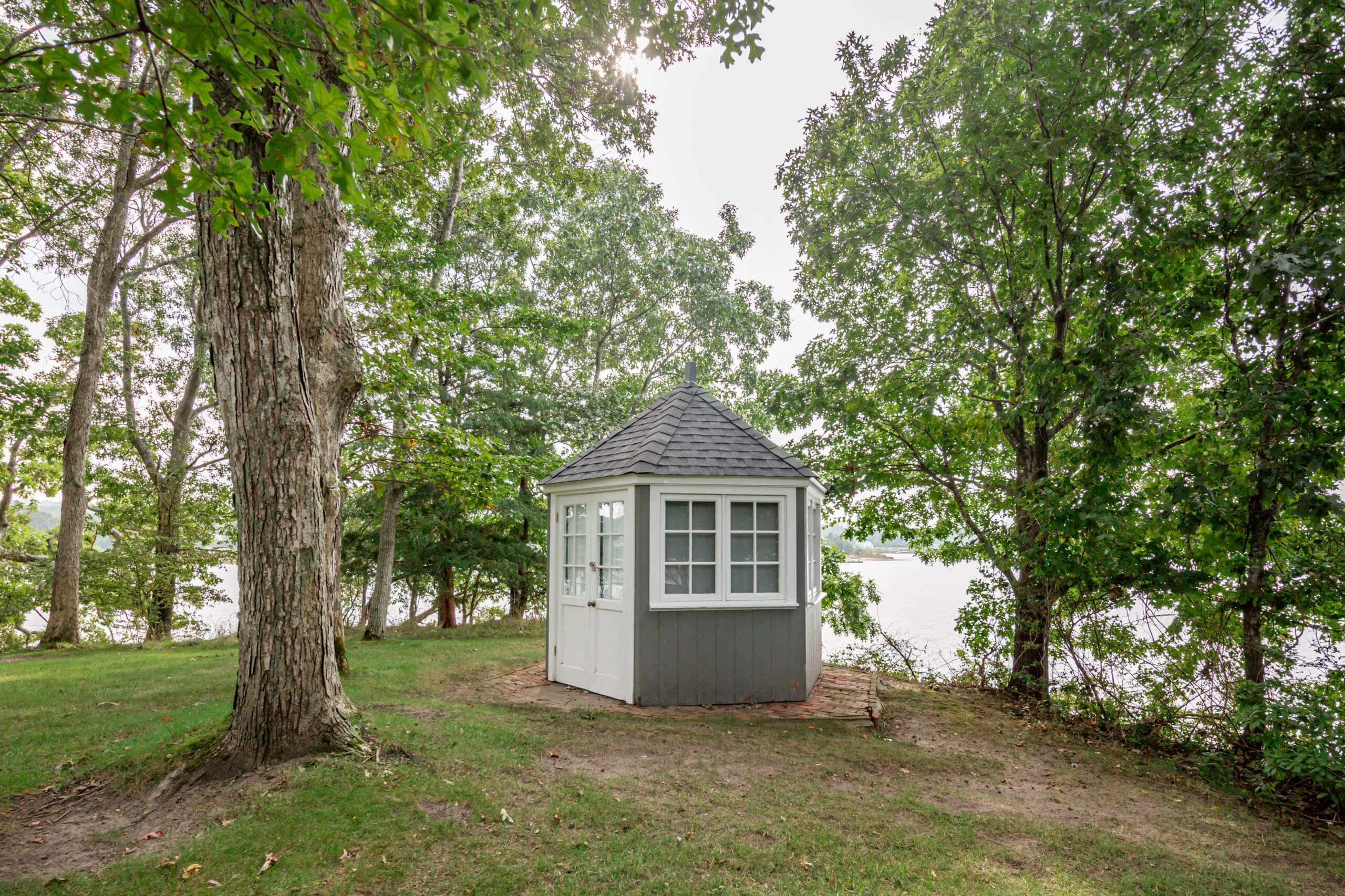“The land is so much more than its analysis,” John Steinbeck wrote in The Grapes of Wrath. One has to wonder how he would take pen to paper about the $17.9 million asking price on the Sag Harbor property he adored so much.
The Pulitzer and Nobel Prize-winning novelist’s modest home and his unique writing studio at 2 Bluff Point Lane are located on a peninsula overlooking Morris Cove and Upper Sag Harbor Cove. Despite his death 53 years ago and that his wife Elaine has been gone 18 years, the property has remained mostly as it was when he wrote The Winter of Our Discontent, his last novel that was published in 1961. No sooner than the news broke that his wife’s heirs had decided to sell the 1.8-acre property on February 19, an effort quickly began to preserve it.
“Sag Harbor has had many writers over the course of the last century. No writer has been as integral,” says Kathryn Szoka, an owner of Canio’s Books in the village, who promptly began a Change.org petition, “Save John Steinbeck’s Home.”
“It is an intangible reason why preservation of his property is essential for the soul of Sag Harbor,” says Szoka, who would love to see it preserved for a writer-in-residence program or a low impact historical museum.
“Steinbeck was so far ahead of his time when it came to issues of ecology, and of course social justice issues,” she says. “He was one of the first American writers to blend those two together in that full range of his writing. That is why Sag Harbor so deeply impacted him.”
“When he took that left turn,” as the story goes, he followed the sign from Montauk Highway to the village, “it was like love at first sight. It so resonated with his memories of Monterey Bay and Pacific Grove, where he grew up.”
Steinbeck, and his third wife, Elaine, whom he married in 1950, first came to Sag Harbor after he completed East of Eden, and purchased the cottage a few years later. It became an unspoiled paradise for him. In fact, a sign that read “Eden” used to sit near the front door.
He found inspiration there, and immersed himself in the small community. Despite having won the Pulitzer Prize for fiction for The Grapes of Wrath in 1940 and then later the Nobel Prize for literature in 1962, he enjoyed relative anonymity in Sag Harbor. He was known to walk around in a fisherman’s cap and rubber boots with his dog, Charley, in tow, even when he went to local dives like the Black Buoy.
In the mornings, he wrote from a gazebo-like structure overlooking the water that he called Joyous Gard, after Lancelot’s castle. It is still located at the tip of the property.
“It’s like a sacred chapel,” says Szoka, who has visited the property. “You just feel it once you are inside. The tin with the pencils is there on the ledge, and the pads of paper. It really is sacred ground.”
From there he penned Travels With Charley, about his cross-country adventure with his dog, and The Winter of Our Discontent, set in a New England village modeled much after Sag Harbor.
“I would offer, The Winter of Our Discontent is a morality tale,” Szoka says. “All of the pieces of that morality tale are playing out right now in Sag Harbor. Right at the heart of the novel is the battle over the sale of the property.”
“There’s no question that real estate in Sag Harbor is at its apex and that makes this kind of discussion more complex,” she adds. “But with that in mind there is also the awareness of the fragility of our cultural capital has also gone. People realize that, ‘Wow. Sag Harbor is sitting on a treasure.’”
The property and its one-story, wood-shingled cottage, located at the end of a long private lane, boasts a rare 586 feet of waterfront that gently slopes down to the water’s edge, providing western-facing sunsets and a 60-foot dock.
The two-bedroom, two-bath house offers just 1,200 square feet of living space. There are nods to Steinbeck. Above a large fieldstone fireplace hangs a painting of Charley. A perch overlooking the living area is “the Library Loft,” which Steinbeck reportedly created with bookcases on three sides.
A guest cottage on the property with views over the water has room to sleep two and offers a bathroom and an outdoor shower. The property also has a free-form pool, or “Cement Pond” as the Steinbecks reportedly called it.
“As soon as you arrive at this property, you know you have arrived somewhere special,” Doreen Atkins at Sotheby’s International Realty told Behind The Hedges when the property first went on the market. “It feels like no other place in the Hamptons. This home is filled with local and literary significance.”
How the public can protect that significance is now the question.
The property is likely eligible for preservation under use of the Peconic Bay Community Preservation Fund. Village officials are working on both national, state and local landmarking, a necessary procedural first step.
There are limiting factors when acquiring properties using the CPF’s historic preservation category, including the ability for public use and public access.
“The theater qualified in the village in a big way in that regards, this one maybe not so much,” says New York State Assemblyman Fred W. Thiele Jr. (I-Sag Harbor), the architect of the community preservation fund, referring to the Sag Harbor Cinema. Because Steinbeck’s property is down a private road, it does not lend itself easily to public access the way the Main Street theater does.
There are options. The land could be purchased, but not the buildings and rather a separate source of funding would be needed. A preservation easement could also protect what is there.
“Ninety percent of the value on the property is the land, not the building,” Thiele says.
The roadblock is going to be asking the asking price.
“It’s an $18 million piece of property in the eyes of the realtor and the family because of who lived there,” says Sag Harbor Village Mayor Kathleen Mulcahy, who is also a real estate agent. “If it was appraised on a regular basis it wouldn’t be anywhere near that.”
She was hesitant to estimate the appraisal value, something that would be undertaken further down in an acquisition process. The house across the street from the Steinbeck property, on a 1.1-acre lot, was relisted last month for $8.25 million.
Property is of course worth what someone is willing to pay.
“There is probably some hedge funder out there who says Grapes of Wrath changed his life,” Thiele says. “It’s like someone paying $5 million to have a Mickey Mantle rookie card.”
When using public dollars though, municipalities can only offer the appraised value.
“CPF could play a role,” Theile adds. “It is something that is worthy to investigate, but it strikes me, largely because of the asking price, that it is probably somewhat of a heavy lift.”
He sees the best opportunity for preservation being with a private-public partnership.
And, who knows, Thiele adds, “There may also be a conservation buyer out there like what happened with Robins Island.” In 1993, Louis Bacon, a Wall Street financier, bought it for $11 million and invested heavily in restoring it.
Mulcahy agrees it will be a heavy lift, but says, “When there’s a will there’s a way.” She loves the idea of a writer’s retreat, some place for other writers “to get inspired by the same things that Steinbeck did.”
The property went on the market on a Friday and by that Sunday she was on a conference call with Southampton Town Supervisor Jay Schneiderman and those involved with the Martha Heasley Cox Center for Steinbeck Studies at San José State University, who she said want to help raise money.
“God love them if they do,” Mulcahy says. “I would love to think there is an angel out there with $18 million who would like to make a writing retreat at Bluff Point.”
This article appeared in the March issue of Behind The Hedges.
Email tvecsey@danspapers.com with further comments, questions or tips. Follow Behind The Hedges on Twitter, Instagram and Facebook.







